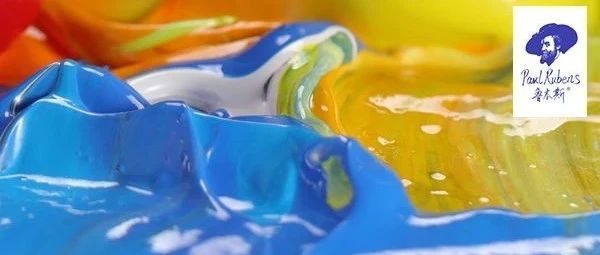Seeing the title of the article, are you ready to answer this question, or are you guessing that Mr. Lu is not going to answer this question? The answer is NO, but I will talk to you about the following yellow oil paints, you will have a surprise after reading them!
Before we start, let's show you a picture of the oil paint label, don't underestimate this picture, it has a hidden meaning! (Click on it to see a larger picture more clearly)

With a small label, you can pretty much know the basic physical properties of the pigment, and even what price range it is in. Even interested parties can also look up more information about it, including how to get it, according to its color number! Of course, here we need to remind you that you should not blindly imitate the operation, or it is likely to become so Oh!

Of course for some people who are gifted and have clear bones, what Mr. Lu wants to say is: "Let go of that paint, I'll ......"

A little addition
In the above label description, the grade there is different for each pigment manufacturer, some are expressed by the letters ABCDEF (such as Old Holland, Rubens) and some are expressed by numbers (such as McHartin is 1-7, Brooks 1-9, Smink 1-8) Although different, they all follow the law of higher prices the further back you go.
Lemon Yellow

We know that there are organic and inorganic lemon yellows, and today we are going to talk about the organic lemon yellow.
About this color, given that we have already told you how to read the pigment label at the beginning, so here I will talk about the part that is not on the label.
PY3

(C16H12N4O4Cl2) Green light single yellow powder. Bright color, melting point 258℃. Oil absorption 25-40 (g/100g), is a low degree of oil absorption pigment.
【ps:Before a small partner message oil absorption rate problem now to see this oil absorption degree division standard: (low oil absorption: below 75% medium oil absorption: 75%-90% deep oil absorption: 90%-150%)]
Although different pigment manufacturers have the same name, but the material used will be different, for example: Mc Hardin 108 lemon yellow is PY31, Brooks 612 lemon yellow is PY184, the old Dutch and our Rubens used the same PY3.
Then we see who the second player is, this player is special, this is a combination, a permanent light yellow, permanent medium yellow, permanent yellow and permanent dark yellow four color combination of the color version of the F4.
Now let's take a look at them one by one.
Permanent light yellow

PY1

( C17H16N4O4) Hansa yellow, light yellow loose powder. Bright color, high coloring power, melting point is 256℃. Oil absorption 25-35(g/100g) is also a low oil absorption pigment.
Permanent medium yellow

PY65 (C18H18N4O6) Reddish yellow powder with brighter color. Melting point 239℃. Heating at 150℃, there is obvious darkening phenomenon when heated for 30min. (Heat resistance 130℃.)

Permanent Yellow

It uses the same color as the permanent medium yellow, PY65, but it is darker than the medium yellow.
The last member of the group, our Rubens permanent dark yellow, is
Permanent Deep Yellow

PY110( C22H6N4O2Cl8)

Red light yellow powder. Bright color, strong coloring power. Good heat resistance, 5min at 280 ℃ does not change color; in 420 ℃ only 4% decomposition, in 465 ℃ before a large number of decomposition began.)
These four colors, lined up together is a bit of network signal sense of sight, you can also use different degrees of color according to their actual needs when using.

Indian Yellow

Indian yellow, as the name implies, originates from India and is made from the urine of cows. The locals feed the cows only mango leaves and water. Since the cows cannot digest the mango leaves, the urine will contain bile, which will be evaporated and filtered to obtain Indian yellow, and then the locals will make this pigment into the size of golf balls for sale. However, these cattle only eat mango leaves, the face is yellow and thin.
Later, for humanitarian reasons, the production and sale of "Indian Yellow" was banned after the 20th century and officially became history in 1921.
Today, most Indian yellows are iron, cobalt or azo yellow pigments with different compositions, all of which have better lightfastness than the natural Indian yellows that fade easily.
Our Rubens Indian yellow is a benzidine pigment under azo pigments ......
PY83( C36H32N6O8Cl4 )●●

联苯胺黄 永固黄 红光黄色粉末。吸油量45-55%,耐热性200℃。
下图为鲁本斯的印度黄与麦克哈丁印度黄的颜料饱和度测试:

镍黄

//PY150 ( C8H4N6O6Ni )
///

由于前几期有小伙伴留言翻牌镉红和镉黄,所以这次鲁先生也将介绍一下这两个无机色。
我们先从镉黄开始;
镉黄

镉黄在整个黄色颜料家族里也算是一个非常通用的颜料了,从1830年,德国开始批量生产镉色起,镉色在艺术家们的圈子里就变得比较唾手可得了。当然这一时期的镉色价格也并不便宜,但其持久性和明亮度、覆盖力和调色能力还是吸引了广大艺术家们的青睐。

镉黄的纯品为CdS或(Cd/Zn)S;主要由硫化镉CdS和硫酸钡BaSO4组成的填充型为CdS-BaSO4或(Cd/Zn)S-BaSO4,又称作镉钡黄即国际标准色卡中的37黄(一种改性型的镉黄,颜色比纯镉黄更加鲜艳)。
大多数国外进口的颜料使用的则是PY35号的镉黄,即含硫化锌的35号黄颜色。含硫化锌(ZnS)的镉黄,其黄色度随ZnS固溶量的增加而变浅,直至淡黄。
在这里我们选取了老荷兰与麦克哈丁跟我们鲁本斯的镉中黄做了一个颜料饱和度的测试,测试结果如下:

PS:另外值得注意镉色具有毒性成分,使用时应加以注意。
镉色是比任何无机色素系列的色相都更广泛,从淡黄到金子般的深黄,较浅的火红到深橙色,鲜艳明亮的猩红到暗红、红褐色。
镉红

镉黄问世一段时间后,镉红才出现,最初是用镉黄和硒一起加热得来的。现代获取镉红的方式就相对较多了。
PR1O8 (CdS·CdSe)
硒硫化镉,为从黄光红至紫酱色粉末,颜色饱满鲜明,色光随硒化镉含量而定,硒化镉含量越高,颜色的红色色光越强。有橙红色、纯红色、暗红色、和光红色等不同品种。具有良好的耐高温、耐碱、耐光和耐大气影响的性能,着色力和遮盖力也很好。
由于镉红色料价格比较贵,所以在一些普通等级的镉红颜料名称后面标有HUE的记号,表示其成分采用的并非真正的镉红而是代用色料,当然若你在其他颜料后面看到这个记号,道理也是一样的。
在镉红的使用中应慎重与含铅、铁和铜的颜料混合使用,以防后期作品会变成黑色。当然在你使用镉红颜料时可以试着加一点镉黄色,这样你会得到更加生动明亮的颜色。

同样的我们选取了布鲁克斯和麦克哈丁及我们鲁本斯的镉红做了一个颜料饱和度的测试,结果如下:


到此本期文章就接近尾声了,虽然大家可能还是不知道梵高为什么如此钟爱黄色油画颜料,但是看在又了解了那么多新的黄色颜料的份上就不要太生气了~~~。





